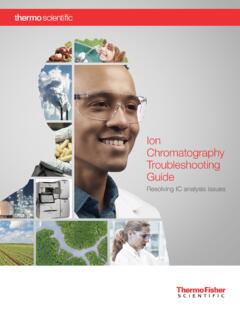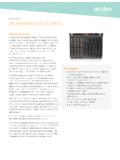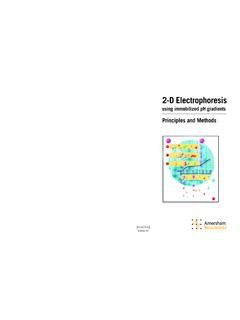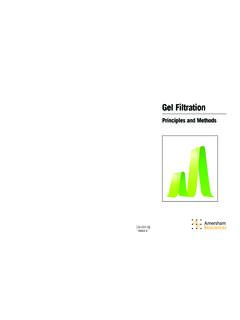Transcription of HPLC Troubleshooting Guide
1 HPLC Troubleshooting Guide Peak Tailing HPLC Columns John Dolan Your decision has lasting effects. Choose wisely. HPLC Columns Ultra Inert Base-Deactivated HPLC Columns For Performance, Selectivity and Guaranteed Reproducibility . performance ACE guarantee If ACE does not outperform your existing column (of equivalent phase, particle size and dimensions), send in your comparative data within 60. days and keep the ACE column FREE OF CHARGE. HPLC Troubleshooting Guide Contents Page Troubleshooting Tables 2. Peak Shape 2. Retention Variation 3. Ghost Peaks 4. Column Backpressure 5. Introduction 6. 1. Peak Shape 6. Peak tailing 6. Insufficient buffer or additive 7. Peak tailing or distortion 8. Poorly resolved peaks 9.
2 Fronting peaks 10. 2. Retention Variation 11. Mobile phase composition changes 11. Column chemistry changes 11. Column temperature changes 12. Flow rate problems 12. Proportioning-valve failures 13. 3. Ghost Peaks 16. Late elution 16. Ghost peaks in gradient runs 17. Negative peaks 17. 4. Column Backpressure 18. Locating pressure problems 18. In-line filters 18. Guard cartridges 18. Buffer precipitation 19. 5. Column Care 20. Equilibration 20. Column flushing 20. Column storage 22. 6. Summary 22. 7. References 23. 8. Solvent Miscibility Chart 24. Quick Reference Tables If you have a problem you need to solve now, use these Troubleshooting Tables. Locate the table for the type of problem you have, find the possible cause and use the short description of the solution or the cross-reference to the main body of the Guide to help you identify and solve your problem quickly.
3 Problems with Peak Shape Possible Cause Prevention/Solution Peak Tailing Interaction with active silanols 1. Use ultra-high purity silica based stationary phase (see ). 2. Add basic mobile phase additive (eg. TEA). not needed with ultra-high purity phases Chelation with metal ions in stationary phase As above Wrong mobile phase pH 1. Decrease mobile phase pH to suppress silanol ionisation (see ). 2. Increase buffer concentration (see ). Blocked frit 1. Reverse flush the column (see ). 2. Use in-line filter (see , ). Column void 1. Reverse flush the column (see ). 2. Replace the column Unswept dead volume 1. Minimise number of connections 2. Use shorter connection tubing 3. Check all fittings are tight Split Peaks Contamination on guard or analytical column 1.
4 Remove guard cartridge and carry out inlet analysis replace guard if necessary 2. Reverse flush analytical column (see ). 3. For strongly retained contaminants, try regeneration procedure (see ). 4. Replace column Blocked frit 1. Reverse flush the column (see ). 2. Use in-line filter (see , ). Sample solvent incompatible with mobile phase 1. Inject sample in mobile phase Simultaneous elution of second component 1. Use sample clean-up prior to injection 2. Change selectivity by changing mobile phase or column phase Column overloaded 1. Use higher capacity stationary phase 2. Increase column diameter 3. Decrease sample amount 2 Problems with Peak Shape (continued). Peak Fronting Formation of channels in column 1.
5 Replace the column 2. Operate within recommended pH limits of column (see ). Column overloaded 1. Inject smaller volume or more dilute sample solution 2. Use higher capacity stationary phase Sample solvent incompatible with mobile phase 1. Inject sample in mobile phase Low temperature 1. Increase column temperature Problems with Retention Variation Possible Cause Prevention/Solution Decreasing Retention Times Loss of bonded stationary phase 1. Replace column 2. Operate at pH 2-8 for silica based RP. columns (see ). Active groups on stationary phase 1. Use organic modifier in mobile phase 2. Increase buffer strength Increasing flow rate 1. Check and adjust pump flow rate (see ). Column overloaded 1.
6 Reduce amount of sample injected 2. Use column with larger Increasing Retention Times Changing mobile phase composition 1. Cover solvent reservoirs (see ). 2. Prepare fresh mobile phase (see ). Loss of bonded stationary phase 1. Replace column Decreasing flow rate 1. Check and adjust pump flow rate (see ). 2. Check for leaks in system, including pump seals (see ). Bubbles in mobile phase 1. Check flow rate and pressure (see ). 2. Degas mobile phase (see ). Fluctuating Retention Times Insufficient column equilibration 1. Equilibrate column longer between runs 2. Condition the column with concentrated sample Change in mobile phase composition 1. Check make-up of mobile phase and make up new if necessary (see ).
7 2. Check proportioning-valve accuracy (see ). Insufficient buffer capacity 1. Use buffer concentrations >20mM. Fluctuating column temperature 1. Stabilise ambient temperature (see ). 2. Thermostat the column (see ). 3. Problems with Ghost Peaks Possible Cause Prevention/Solution Ghost Peaks Contamination in column or injector 1. Use only HPLC grade solvents 2. Flush column to remove impurities (see ). 3. Flush injector between analyses Late eluting peak from previous injection 1. Extend run time (see ). 2. Flush column with strong mobile phase at end of each run (see ). 3. For gradient runs, end at higher concentration (see ). Contaminated water in RP HPLC 1. Use HPLC grade water (see ). Unknown interferences in sample 1.
8 Use sample clean-up ( SPE). Negative Peaks Refractive index of solute lower than that of 1. Use mobile phase with lower refractive index mobile phase (RI detector) 2. Reverse detector polarity to obtain positive peaks Absorption of solute lower than absorption 1. Change UV wavelength of mobile phase (UV detector) 2. Use mobile phase with lower UV. absorption (see ). Sample solvent and mobile phase differ in 1. Change sample solvent and dissolve composition sample in mobile phase if possible Spikes Air bubbles in mobile phase 1. Degas mobile phase 2. Install back pressure restrictor at detector outlet 3. Ensure all fittings are tight Column stored without endcaps 1. Store columns with endcaps (see ).
9 2. Flush RP column with degassed methanol 4 Problems with Column Backpressure Possible Cause Prevention/Solution High Backpressure Wrong pump setting and correct setting Normal for system Increased backpressure normal if: 1. Switched to longer column 2. Changed to smaller particles 3. Changed to smaller diameter 4. Increased flow rate if no other changes made Pressure higher during middle of gradient 1. Normal Temperature too low 1. Adjust column oven temperature Column ageing 1. Gradual increase in pressure normal over column lifetime Blocked column frit 1. Reverse flush the column (see ). 2. Use in-line filter (see , ). 3. Centrifuge or filter samples 4. Use guard cartridges (see ). Blocked in-line filter 1.
10 Replace in-line filter frit (see ). 2. Centrifuge or filter samples 3. Pre-filter mobile phase Blocked guard cartridge 1. Replace guard cartridge more frequently (see ). System blockage 1. Systematically investigate system to find blockage (see ). Buffer precipitation 1. Reverse flush the column with water(see ). 2. Review evaluation conditions (see ). Low Backpressure Leak in system 1. Locate leak and correct Column temperature too high 1. Lower temperature Flow too low 1. Increase flow rate 5. Introduction This Troubleshooting Guide contains examples of some of the most common problems observed in reversed-phase HPLC (RP-HPLC) separations. Four major problem areas are covered: peak shape, retention time changes, ghost peaks and problems related to column backpressure.












